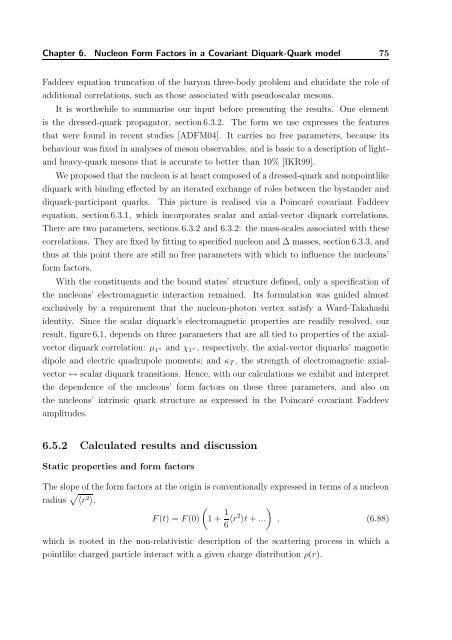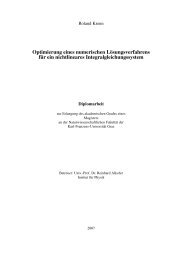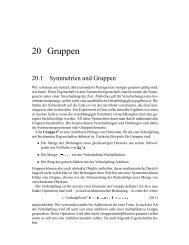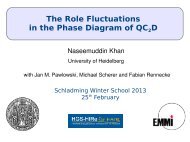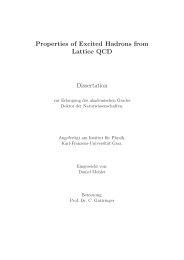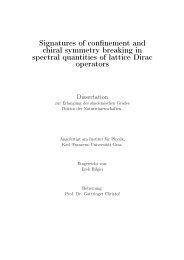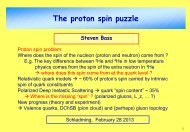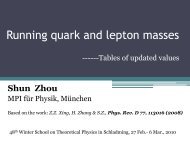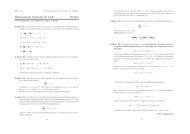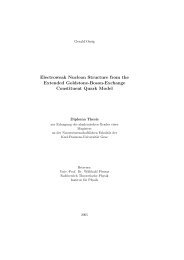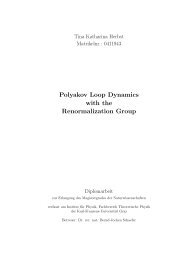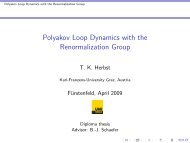The QCD Quark Propagator in Coulomb Gauge and - Institut für Physik
The QCD Quark Propagator in Coulomb Gauge and - Institut für Physik
The QCD Quark Propagator in Coulomb Gauge and - Institut für Physik
You also want an ePaper? Increase the reach of your titles
YUMPU automatically turns print PDFs into web optimized ePapers that Google loves.
Chapter 6. Nucleon Form Factors <strong>in</strong> a Covariant Diquark-<strong>Quark</strong> model 75<br />
Faddeev equation truncation of the baryon three-body problem <strong>and</strong> elucidate the role of<br />
additional correlations, such as those associated with pseudoscalar mesons.<br />
It is worthwhile to summarise our <strong>in</strong>put before present<strong>in</strong>g the results. One element<br />
is the dressed-quark propagator, section6.3.2. <strong>The</strong> form we use expresses the features<br />
that were found <strong>in</strong> recent studies [ADFM04]. It carries no free parameters, because its<br />
behaviour was fixed <strong>in</strong> analyses of meson observables, <strong>and</strong> is basic to a description of light<strong>and</strong><br />
heavy-quark mesons that is accurate to better than 10% [IKR99].<br />
We proposed that the nucleon is at heart composed of a dressed-quark <strong>and</strong> nonpo<strong>in</strong>tlike<br />
diquark with b<strong>in</strong>d<strong>in</strong>g effected by an iterated exchange of roles between the byst<strong>and</strong>er <strong>and</strong><br />
diquark-participant quarks. This picture is realised via a Po<strong>in</strong>caré covariant Faddeev<br />
equation, section6.3.1, which <strong>in</strong>corporates scalar <strong>and</strong> axial-vector diquark correlations.<br />
<strong>The</strong>re are two parameters, sections.6.3.2 <strong>and</strong> 6.3.2: the mass-scales associated with these<br />
correlations. <strong>The</strong>y are fixed by fitt<strong>in</strong>g to specified nucleon <strong>and</strong> ∆ masses, section6.3.3, <strong>and</strong><br />
thus at this po<strong>in</strong>t there are still no free parameters with which to <strong>in</strong>fluence the nucleons’<br />
form factors.<br />
With the constituents <strong>and</strong> the bound states’ structure def<strong>in</strong>ed, only a specification of<br />
the nucleons’ electromagnetic <strong>in</strong>teraction rema<strong>in</strong>ed. Its formulation was guided almost<br />
exclusively by a requirement that the nucleon-photon vertex satisfy a Ward-Takahashi<br />
identity. S<strong>in</strong>ce the scalar diquark’s electromagnetic properties are readily resolved, our<br />
result, figure6.1, depends on three parameters that are all tied to properties of the axialvector<br />
diquark correlation: µ 1 + <strong>and</strong> χ 1 +, respectively, the axial-vector diquarks’ magnetic<br />
dipole <strong>and</strong> electric quadrupole moments; <strong>and</strong> κ T , the strength of electromagnetic axialvector<br />
↔ scalar diquark transitions. Hence, with our calculations we exhibit <strong>and</strong> <strong>in</strong>terpret<br />
the dependence of the nucleons’ form factors on these three parameters, <strong>and</strong> also on<br />
the nucleons’ <strong>in</strong>tr<strong>in</strong>sic quark structure as expressed <strong>in</strong> the Po<strong>in</strong>caré covariant Faddeev<br />
amplitudes.<br />
6.5.2 Calculated results <strong>and</strong> discussion<br />
Static properties <strong>and</strong> form factors<br />
<strong>The</strong> slope of the form factors at the orig<strong>in</strong> is conventionally expressed <strong>in</strong> terms of a nucleon<br />
radius √ 〈r 2 〉,<br />
(<br />
F(t) = F(0) 1 + 1 )<br />
6 〈r2 〉t + ...<br />
, (6.88)<br />
which is rooted <strong>in</strong> the non-relativistic description of the scatter<strong>in</strong>g process <strong>in</strong> which a<br />
po<strong>in</strong>tlike charged particle <strong>in</strong>teract with a given charge distribution ρ(r).


